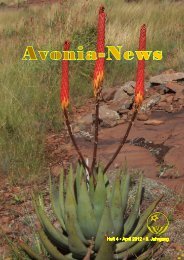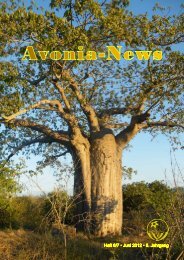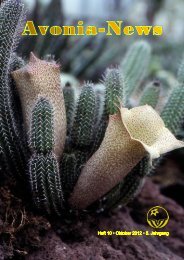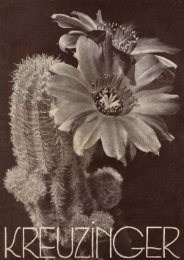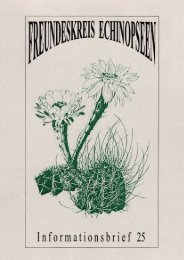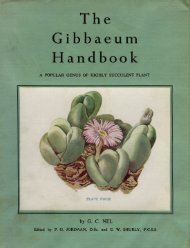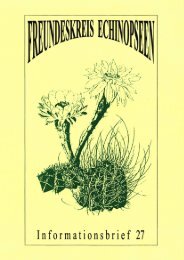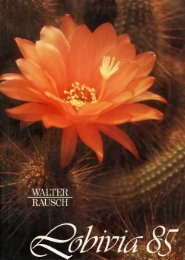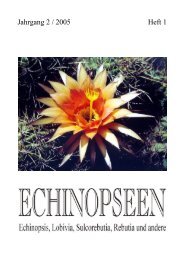Lithops - Au Cactus Francophone
Lithops - Au Cactus Francophone
Lithops - Au Cactus Francophone
You also want an ePaper? Increase the reach of your titles
YUMPU automatically turns print PDFs into web optimized ePapers that Google loves.
perience, namely that, although one can determine the general nature of the<br />
colour, such as yellow for example, there are so many shades of this colour<br />
that when one wants to describe a specific shade the difficulty starts. The top<br />
surface is often not uniform in colour as for example in L. pseudotruncatella.<br />
Furthermore small areas of the upper surface often differ from one another,<br />
as in L. karasmontana, thus while the description may be true for one part<br />
of the top it is not correct for a part a few millimetres away.<br />
As the leaves become older, the differences of the various parts become<br />
accentuated. When plants are removed from their natural habitat and grown<br />
in Europe and in the moister parts of South Africa the top tends to lose its<br />
brilliance. The plant also under such conditions protrudes above the ground,<br />
becomes more concave, and assumes a greener tint than material fresh from<br />
the field.<br />
A representative of this genus which thrives in a part of the country<br />
(Bethlehem, Pretoria) with a fairly heavy rainfall is L. Lesliei. L. terricolor<br />
though occasionally found near Port Elizabeth, which has a fairly regular and<br />
heavy rainfall, is characteristic of the driest parts of the Cape Province (Ceres,<br />
Karroo, Laingsburg) with about two inches per year.<br />
There is sometimes a marked difference between the colouration of<br />
the depressions and the ridges of the rugose species such as L. karasmontana,<br />
L. gracilidelineata. The network, which is sometimes a prominent feature of<br />
the top surface, also shows a great deal of variation, not only in the way it<br />
anastomises but also in its colouration. An extreme case is that of L. pseu‑<br />
dotruncatella and L. verruculosa. The case of L. Vallis‑Mariae should also be<br />
mentioned. In thus particular plant, the surface which appears uniform to<br />
the naked eve consists in reality of a large number of ridges with vermiform<br />
convolutions, giving the idea of sintered limestone.<br />
In determining a species of <strong>Lithops</strong> a careful and close study must be<br />
made of the markings, especially those on the depressions. L. Erniana has<br />
a darkly coloured depression, but at the end of this depression one notices<br />
short brown lines with a buff border. These lines stand at right angles to the<br />
main depression. Red dots or short lines mark the intersection of the slight<br />
depressions of L. chrysocephala.<br />
Species with red dots or warts fall into two distinct groups: (i) those<br />
like L. Dinteri, L. Dorotheae and L. insularis, where the red dots are embedded<br />
in the tissue and are level with it, and (ii) L. Inae, where the red shiny dots<br />
stand up above the surface of the leaf. In the first group the cell walls are<br />
coloured red, whereas in L. Inae the cell cavities contain the liquid anthocyan.<br />
10<br />
WINDOW<br />
As already pointed out the top surface of the leaf is apparently opaque,<br />
although it lets light through as can be easily proved by cutting the top off,




